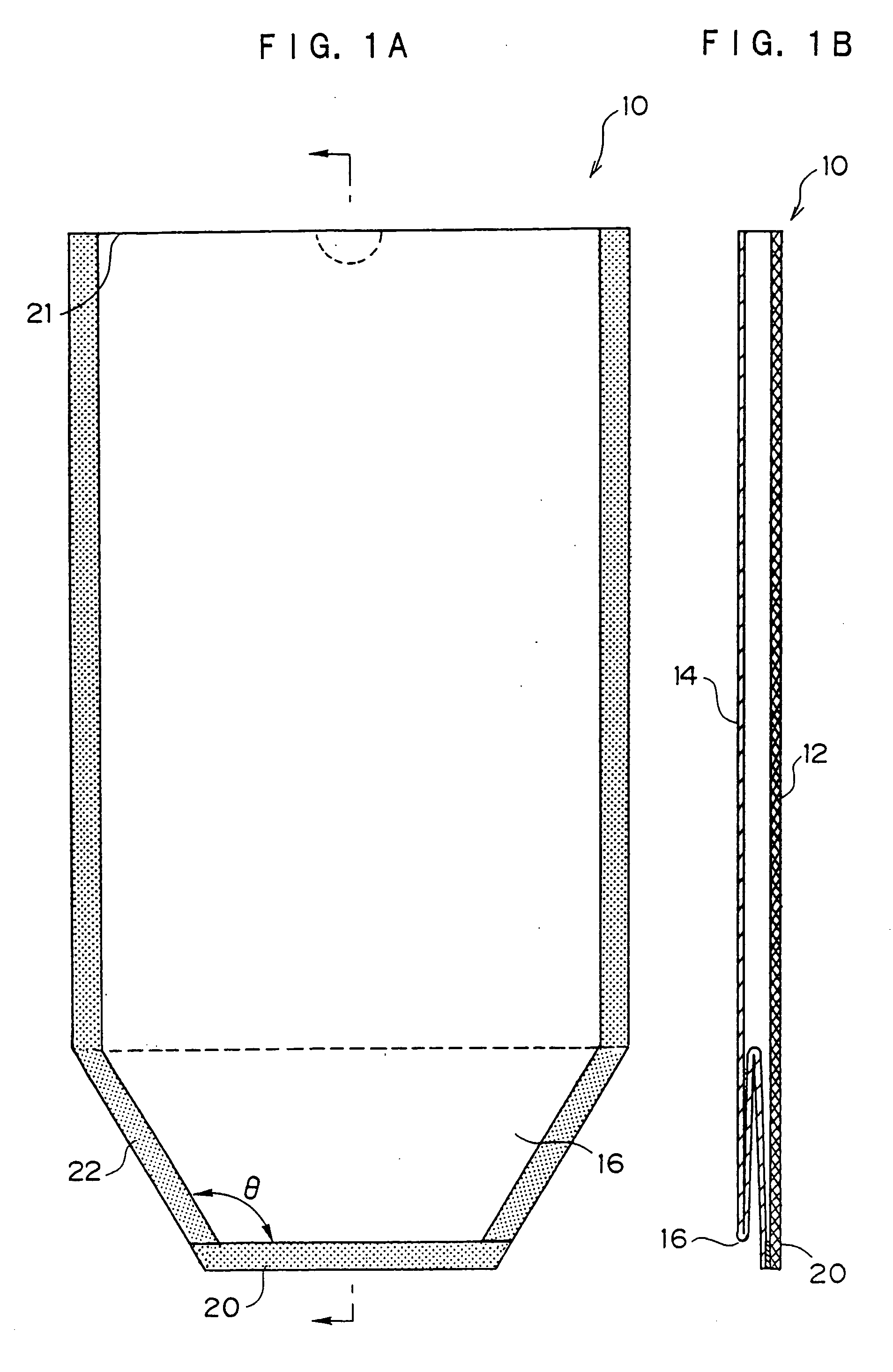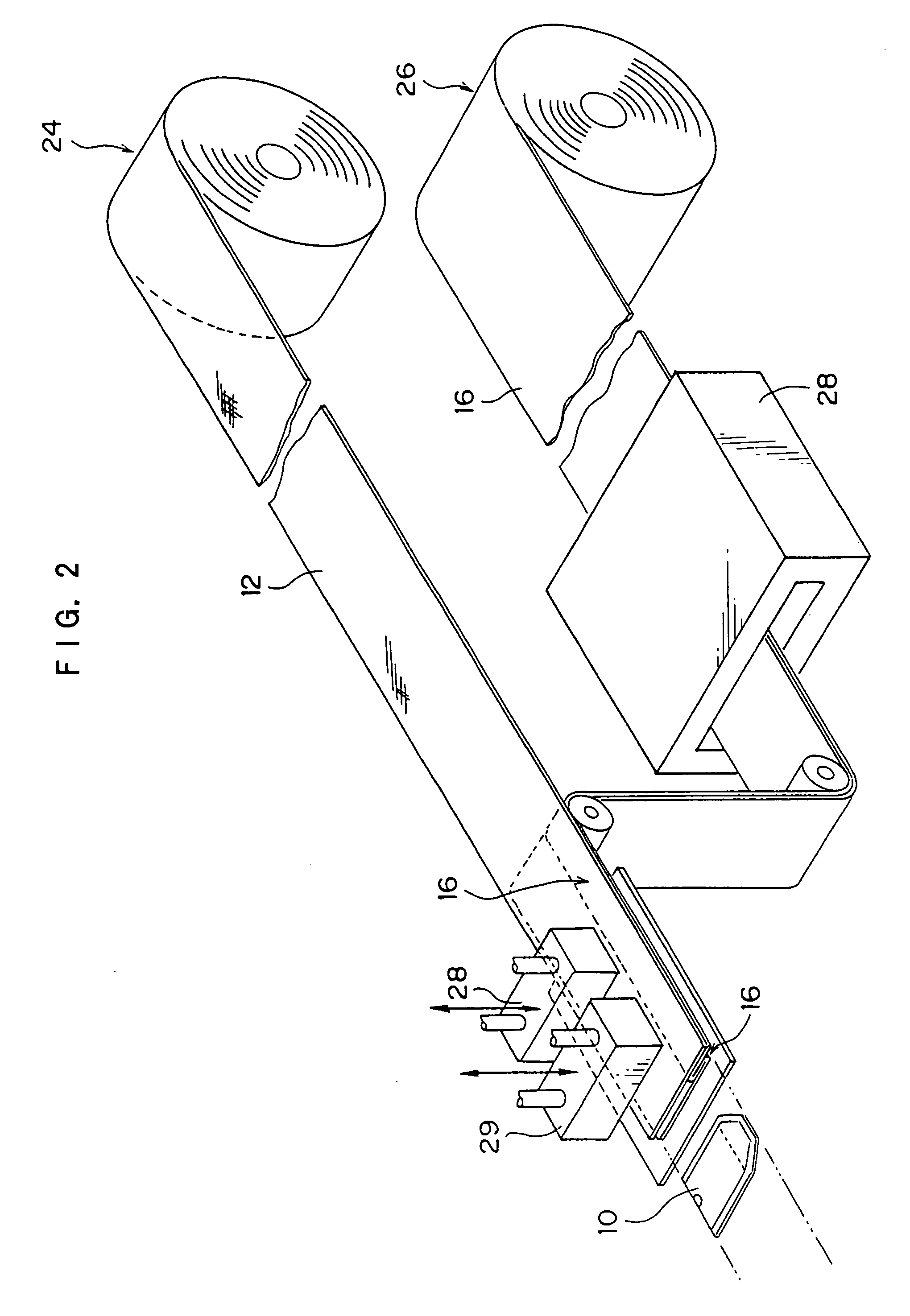Sterile bag
a sterile bag and sterile technology, applied in the field of sterile bags, can solve the problems of heat-sealed portion peeling and opening, paper substrate damage, pinhole formation, etc., and achieve the effect of suppressing the occurrence of accidental opening and damage due to contact with sharp tips
- Summary
- Abstract
- Description
- Claims
- Application Information
AI Technical Summary
Benefits of technology
Problems solved by technology
Method used
Image
Examples
example 1
[0089] A synthetic resin film 14 and a gas-permeable substrate (side surface film) 12 were prepared. The gas-permeable substrate (side surface film) 12 was a high-density polyethylene non-woven cloth having a width of 300 mm. The synthetic resin film 14 was composed of a biaxially oriented PET film having a thickness of 12 μm, a biaxially oriented nylon film having a thickness of 15 μm, and a PP film having a thickness of 30 μm. One end portion of the synthetic resin film 14 was folded to form a bulging portion 16 which had an N-shape cross section and whose height (width of the overlapping portion of the folded portion) was 40 mm. Thereafter, the synthetic resin film 14 was disposed on the gas-permeable substrate 12 so that an end of the synthetic resin film 14 serving as an end (unfolded end) of the bulging portion coincided with one end of the gas permeable substrate 12 and so that the distance between the other end (folded end) of the bulging portion and the one end of the gas p...
example 2
[0091] A gas-permeable substrate 12 made of sterilization paper and having a width of 70 mm, a height of 350 mm and a weight of 70 g / m2, and a synthetic resin film 14 having the same measurements as those of the gas-permeable substrate 12 and composed of a biaxially oriented PET film having a thickness of 12 μm and a PP film having a thickness of 30 μm were used. A polypropylene non-woven fabric having a width of 70 mm, a height of 45 mm and a weight of 40 g / m2 was used as the protective component 116. The protective component was disposed on one end portion of the gas-permeable substrate 12 so that the protective component 116 and the one end portion of the gas-permeable substrate 12 coincided with each other. The entire surface of the overlapping portion was heat sealed.
[0092] The synthetic resin film 14 and the gas-permeable substrate 12 were layered, with the protective component 116 sandwiched between them. A heat-sealed portion having a width of 10 mm was formed in the lower ...
example 3
[0094] A sterilization bag 130 having a width of 170 mm and a height of 300 mm, as shown in FIG. 8, was produced in the same manner as in Example 2, except that the following points were changed. That is, the width and height of the protective component 116 were 70 mm and 60 mm, respectively. The protective component 116 was folded in two so that the height became half. One end portion of the protective component 116 was disposed on a gas-permeable substrate 12, and the other end portion thereof was disposed on a synthetic resin film 14 so that the distance between the folding line of the protective component 116 and each of the lower end portions of the gas-permeable substrate 12 and the synthetic resin film 14 was 15 mm. Then, only both ends of the protective component 116 were respectively heat sealed to the gas-permeable material 12 and the synthetic resin film 14 to form heat-sealed portions having a width of 5 mm. A heat sealed portion disposed at the lower end portion of the ...
PUM
| Property | Measurement | Unit |
|---|---|---|
| Angle | aaaaa | aaaaa |
| Angle | aaaaa | aaaaa |
| Permeability | aaaaa | aaaaa |
Abstract
Description
Claims
Application Information
 Login to View More
Login to View More - R&D
- Intellectual Property
- Life Sciences
- Materials
- Tech Scout
- Unparalleled Data Quality
- Higher Quality Content
- 60% Fewer Hallucinations
Browse by: Latest US Patents, China's latest patents, Technical Efficacy Thesaurus, Application Domain, Technology Topic, Popular Technical Reports.
© 2025 PatSnap. All rights reserved.Legal|Privacy policy|Modern Slavery Act Transparency Statement|Sitemap|About US| Contact US: help@patsnap.com



